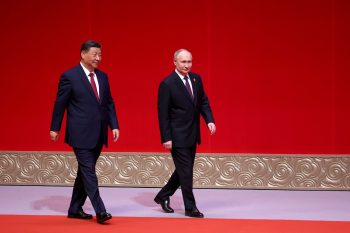
October 10, 2024 • Analysis •
At the end of October, the Russian city of Kazan, in Tatarstan, will host a new summit of the SCO (Shanghai Cooperation Organization). As with BRICS+, Vladimir Putin’s Eurasian Russia and Xi Jinping’s neo-Maoist China are at the heart of this “machinery,” supposedly delivering a post-Western world. These are two powers that coordinate their policies and maneuver together. This is what we must rightly call the Sino-Russian axis. This text is an expanded version of the presentation at the symposium “China-Russia: Affinities and Differences” (Sorbonne, 10/5/2024), during the round table titled “Expansionist Policy and Methods of Power Projection.”
This alliance unites two revisionist powers, which the late French Admiral Raoul Castex referred to as “disruptive states.” By definition, these are states engaged in various forms of expansion (territorial expansion and, more broadly, power expansion), driven by deep resentment and a strong sense of vindication. This psychopolitical complex has found a concrete expression that goes far beyond rhetorical convergence: Moscow and Beijing mutually support each other. However, we must note the reluctance of politicians and experts to speak of a Sino-Russian alliance or axis. Why such reticence?
On Russia and China as global geostrategic actors
Those who deny any alliance between China and Russia highlight the power asymmetry between the two countries in demographic, economic, technological, and commercial terms. While China seems destined to become a global superpower, Russia could be described as a declining power, regional at best. Whereas China is said to display “strategic patience,” Russia, pressed for time, is seen as rushing forward, as evidenced by the “special military operation” launched on February 24, 2024. In short, Russia is perceived as a weather anomaly, while the Chinese challenge is compared to climate change (an idea already expressed during the Obama administration).
As vivid as this image may be, it is questionable. It is essential not to exaggerate Russia’s weakness by evaluating it solely on the basis of its overall GDP (1.8% of annual global production). Russia is a key player in several crucial sectors of the world economy (hydrocarbons, minerals, cereals, civil nuclear energy, arms, and space). Despite the sanctions, Russian technocrats have managed to preserve the “fundamentals” of the economy (public deficit, debt, foreign trade). Its strategic arsenal and propensity to use armed violence also factor into the equation. In short, Russia’s power and influence surpass its global economic weight. As for China, it faces heavy burdens, with some observers referring to it as a “sub-power,” though this does not diminish Xi Jinping’s thirst for power. In any case, Sino-Russian relations are not as unbalanced as they seem.
The hypothesis of desynchronization
The concurrent hypothesis that China and Russia would not exert their power on the same timelines seems flawed. Such an assertion is based on a one-dimensional view of time, corresponding to what the ancient Greeks called Chronos: a homogeneous time that flows uniformly (the time of matter). However, history unfolds through successive ruptures. While there are periods of stasis (comparable to the “punctuated equilibrium” of neo-Darwinism), there are also critical moments or tipping points. This configuration corresponds to Kairos: the opportune moment, the sign the gods send to the city. The “tipping point” opens onto a new long cycle, which is the third dimension of time in ancient Greek thought: Aion (the “aeons” of Neoplatonic philosophy).
This is how Vladimir Putin, Xi Jinping, and their allies understand the current era. In summary, the bell has supposedly tolled for the West, and their time has come, the time of Sino-Russian Eurasia or Greater Asia. As such, their countries support each other, from the Ukrainian theater to the Taiwan Strait, from one end of the Eurasian landmass to the other—politically, diplomatically, ideologically, as well as economically and militarily (through concrete cooperation, deliveries, and military exercises). All this with the prospect of a major confrontation with the United States and its allies, possibly leading to a hegemonic war. It is crucial to emphasize that their needs are mutual: China provides multifaceted support to Russia’s war against Ukraine; it views Russia as a “great rear” whose assistance, in the event of war in the South China Sea and the Western Pacific, would be vital. For now, the aim is to stretch the United States across the primary theaters of the Old World (Europe, the Middle East, and the Far East).
An alliance that remains unspoken
In truth, there is no formal alliance in the Westphalian sense — no proper alliance; such an arrangement would be too Western for powers that see themselves as civilization-states, a break with the West. Let us, however, refer to an academic definition of an alliance: “An association of interests aimed at establishing a balance of power favorable to achieving an objective in a conflictual environment.” From this perspective, we would not hesitate to call the Sino-Russian axis an alliance, directed against a designated enemy, with the goal of creating a post-Western world ruled by Beijing and Moscow. This alliance has extensions in the Middle East (Islamic Iran) as well as in Northeast Asia (the Pyongyang regime). On a global scale, the Chinese and Russians maneuver in the “Global South” (the Russians speak of the “World Majority”) to reduce the West to a geopolitical minority.
Yet, diagnosing this reality seems difficult. Some argue that such an alliance cannot exist due to the asymmetry between the Russians and Chinese. So what? Does NATO unite countries of equal or comparable power? Another objection lies in the absence of a mutual defense clause (which was sometimes the case in history), but the Sino-Russian alliance is based primarily on a back-to-back logic. Moreover, while there are Sino-Russian divergences, it must be acknowledged that their convergences prevail. Finally, it is argued that this apparent alliance is circumstantial, but aren’t all alliances tied to specific historical contexts? Beyond the psychological denial of a situation slipping away from us, the difficulty may also stem from the biases of rationalist political theories, marked by economism: the focus on “interests” supposedly explains everything, underestimating passions, and ignoring depth psychology. In short, the difficulty in grasping the irreducibility of politics (its very essence): the original nature of conflict and the impossibility of dissolving the concept of enemy.
In conclusion
Ultimately, the reluctance to consider the Sino-Russian axis and its extensions reflects the dominance of post-modern theoretical frameworks in the human sciences and tells us something about contemporary Western societies and their inclination toward radical relativism. There would no longer be recognizable things with defined forms and contours; the world would only be a process, fluidity. Thus, nothing should be taken literally; this paralysis of language makes it impossible to speak plainly and, in this case, to identify the enemy.
Nonetheless, the Moscow-Beijing axis is a reality, evidenced by strong convergences and mutual support. Russian and Chinese leaders are deeply determined in their opposition to the West, explicitly designated as the enemy (it would be futile to pretend not to hear this). This is significant; there is no need for a grand inaugural moment, like the signing of the North Atlantic Treaty on April 4, 1949, to finally dare to speak of a Sino-Russian alliance. Let us be convinced that the worst lies ahead and that we will need to confront it, in a coordinated manner, on the various theaters where the fate of the West is being decided.

